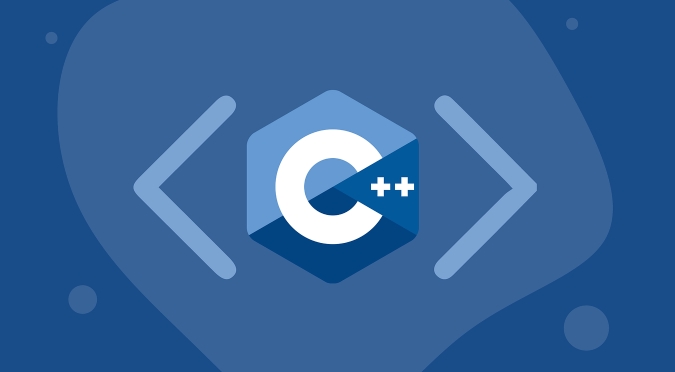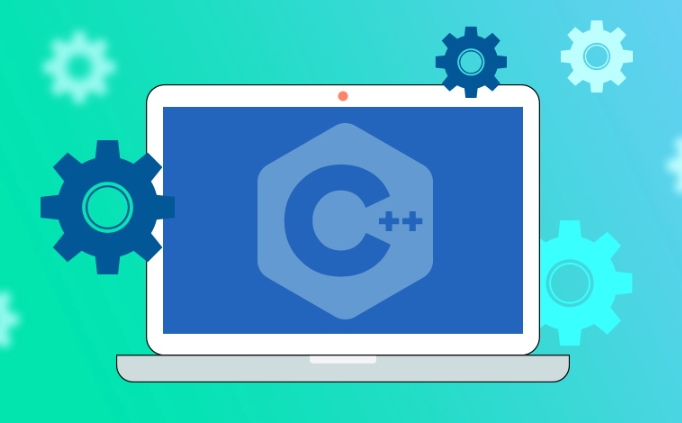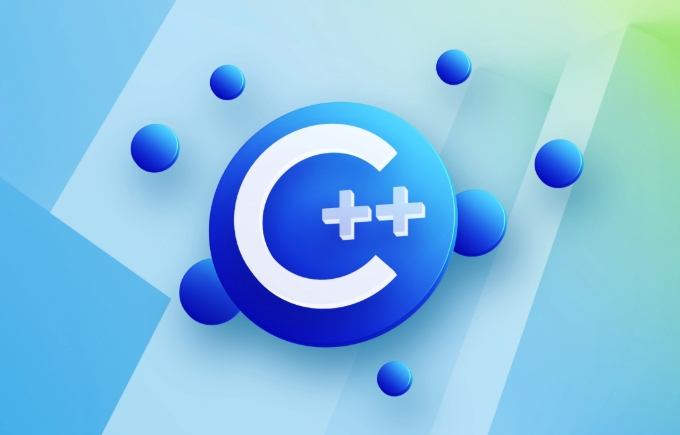An abstract class is a class containing at least one pure virtual function. It cannot be instantiated and must be inherited as a base class. The derived class needs to implement all its pure virtual functions, otherwise it will still be an abstract class. 1. Pure virtual functions are declared by virtual return type function name() = 0; and are used to define interface specifications; 2. Abstract classes are often used for unified interface design, such as area(), draw(), etc., to implement polymorphic calls; 3. Virtual destructors (such as virtual ~Shape() = default;) must be provided for abstract classes to ensure that derived class objects are correctly released through base class pointers; 4. After the derived class inherits, pure virtual functions need to be rewrite, such as Rectangle and Circle to implement area() to calculate their respective areas; 5. Different subclass objects can be managed uniformly through base class pointer arrays to achieve runtime polymorphism. This mechanism simulates Java interface-like functions in C and is an important means to separate interfaces and implement them in object-oriented design.

In C, an abstract class is a class containing at least one pure virtual function and cannot be instantiated and is usually used as a base class to define an interface.

Below is a simple C abstract class example to help you understand its usage and function.
? Example: Abstract base class of graph class
Suppose we want to design a graphics processor that supports multiple graphics (such as circles and rectangles), and each of them can calculate the area. We can define an abstract class Shape that contains a pure virtual function area() .

#include <iostream>
#include <cmath>
using namespace std;
// Abstract base class Shape {
public:
// Pure virtual function: no implementation, subclasses must be overridden virtual double area() const = 0;
// Ordinary virtual destructor (recommended)
virtual ~Shape() = default;
// There can be a normal member function void printArea() const {
cout << "Area: " << area() << endl;
}
};
// Derived class: Rectangle: public Shape {
private:
double width, height;
public:
Rectangle(double w, double h) : width(w), height(h) {}
// Implement the pure virtual function double area() const override {
return width * height;
}
};
// Derived class: Circle: public Shape {
private:
double radius;
public:
Circle(double r) : radius(r) {}
// Implement the pure virtual function double area() const override {
return M_PI * radius * radius;
}
};?User Example
int main() {
// Shape shape; // ? Error! Abstract class cannot instantiate Shape* shapes[] = {
new Rectangle(4.0, 5.0),
new Circle(3.0)
};
for (auto s : shapes) {
s->printArea(); // polymorphic call}
// Remember to free memory for (auto s : shapes) {
delete s;
}
return 0;
}Output:
Area: 20 Area: 28.2743
? Summary of key points
- Pure virtual function : declared with
virtual 返回類型函數(shù)名() = 0; - Abstract classes cannot be instantiated : they can only be inherited as base classes.
- A derived class must implement all pure virtual functions , otherwise it will become an abstract class itself.
- Virtual destructors are important : prevent undefined behavior when deleting derived class objects.
? When to use abstract classes?
- Define a unified interface (such as
draw(),update(),serialize(), etc.). - Force subclasses to provide implementations of specific functions.
- Implement polymorphism and manage different types of objects in a unified manner.
Basically that's it. Abstract classes are an important means for C to implement the idea of ??"interface" in object-oriented design. Although they do not have interface keywords like Java, similar effects can be achieved through pure virtual functions.

The above is the detailed content of C abstract class example. For more information, please follow other related articles on the PHP Chinese website!

Hot AI Tools

Undress AI Tool
Undress images for free

Undresser.AI Undress
AI-powered app for creating realistic nude photos

AI Clothes Remover
Online AI tool for removing clothes from photos.

ArtGPT
AI image generator for creative art from text prompts.

Stock Market GPT
AI powered investment research for smarter decisions

Hot Article

Hot Tools

Notepad++7.3.1
Easy-to-use and free code editor

SublimeText3 Chinese version
Chinese version, very easy to use

Zend Studio 13.0.1
Powerful PHP integrated development environment

Dreamweaver CS6
Visual web development tools

SublimeText3 Mac version
God-level code editing software (SublimeText3)
 How to compile and run a C program
Sep 16, 2025 am 05:29 AM
How to compile and run a C program
Sep 16, 2025 am 05:29 AM
InstallaC compilerlikeg usingpackagemanagersordevelopmenttoolsdependingontheOS.2.WriteaC programandsaveitwitha.cppextension.3.Compiletheprogramusingg hello.cpp-ohellotogenerateanexecutable.4.Runtheexecutablewith./helloonLinux/macOSorhello.exeonWi
 C custom allocator example
Sep 17, 2025 am 08:45 AM
C custom allocator example
Sep 17, 2025 am 08:45 AM
Custom allocator can be used to control the memory allocation behavior of C containers. 1. The LoggingAllocator in the example implements memory operation logging by overloading allocate, deallocate, construct and destroy methods; 2. The allocator needs to define value_type and rebind templates to meet the STL container type conversion requirements; 3. The allocator triggers log output during construction and copying, which is convenient for tracking the life cycle; 4. Actual applications include memory pools, shared memory, debugging tools and embedded systems; 5. Since C 17, construct and destroy can be processed by std::allocator_traits by default
 How to execute a system command in C
Sep 21, 2025 am 04:35 AM
How to execute a system command in C
Sep 21, 2025 am 04:35 AM
Use the std::system() function to execute system commands, which need to include header files and pass in C-style string commands, such as std::system("ls-l"), and the return value is -1, which means that the command processor is not available.
 C abstract class example
Sep 15, 2025 am 05:55 AM
C abstract class example
Sep 15, 2025 am 05:55 AM
An abstract class is a class containing at least one pure virtual function. It cannot be instantiated and must be inherited as a base class. The derived class needs to implement all its pure virtual functions, otherwise it will still be an abstract class. 1. Pure virtual functions are declared by virtual return type function name()=0; to define interface specifications; 2. Abstract classes are often used for unified interface design, such as area(), draw(), etc., to implement polymorphic calls; 3. Virtual destructors must be provided for abstract classes (such as virtual~Shape()=default;) to ensure that derived class objects are correctly released through base class pointers; 4. After the derived class inherits, pure virtual functions must be rewrite, such as Rectangle and Circle to implement area() to calculate their respective areas; 5.
 How to implement a custom iterator in C
Sep 20, 2025 am 01:13 AM
How to implement a custom iterator in C
Sep 20, 2025 am 01:13 AM
The answer is to define a class that contains the necessary type alias and operations. First, set value_type, reference, pointer, difference_type and iterator_category, then implement dereference, increment and comparison operations. Finally, provide begin() and end() methods in the container to return the iterator instance, making it compatible with STL algorithms and range for loops.
 How to create a static variable in C
Sep 19, 2025 am 05:24 AM
How to create a static variable in C
Sep 19, 2025 am 05:24 AM
AstaticvariableinC retainsitsvaluebetweenfunctioncallsandisinitializedonce.2.Insideafunction,itpreservesstateacrosscalls,suchascountingiterations.3.Inaclass,itissharedamongallinstancesandmustbedefinedoutsidetheclasstoavoidlinkingerrors.4.Staticvaria
 Why do real-time systems need deterministic response guarantees?
Sep 22, 2025 pm 04:03 PM
Why do real-time systems need deterministic response guarantees?
Sep 22, 2025 pm 04:03 PM
Real-time systems require deterministic responses, because correctness depends on the result delivery time; hard real-time systems require strict deadlines, missed will lead to disasters, while soft real-time allows occasional delays; non-deterministic factors such as scheduling, interrupts, caches, memory management, etc. affect timing; the construction plan includes the selection of RTOS, WCET analysis, resource management, hardware optimization and rigorous testing.
 How to read a whole file into a string in C
Sep 18, 2025 am 06:07 AM
How to read a whole file into a string in C
Sep 18, 2025 am 06:07 AM
Use std::ifstream and std::istreambuf_iterator to efficiently read the entire contents of the file to strings, including spaces and line breaks, and is suitable for medium-sized text files.




